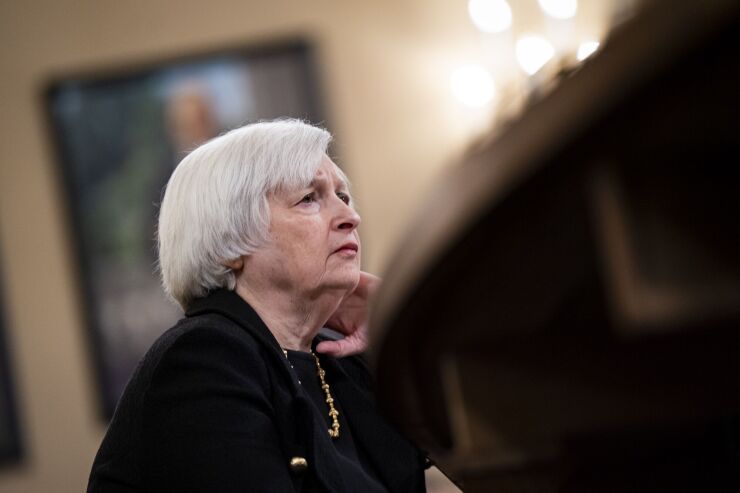The prospect of a fresh round of tax cuts next year is helping Donald Trump woo Wall Street donors but threatens to add trillions of dollars to the national debt.
The
Independent analyses show that wasn't true of Trump's 2017 tax cuts and won't be the case if they're renewed in 2025. That sets up a big political fight over how — and even whether — to pay for them.
This time the nation's debt load and interest costs are much heavier burdens after the deficit-financed Trump tax cuts, multiple rounds of pandemic stimulus and Biden administration spending on its signature clean energy, infrastructure and chip manufacturing initiatives.
U.S. government debt held by the public soared from 76% of GDP in 2017 to 97% of GDP in December. Yields investors demand on 10-year U.S. Treasury bonds nearly doubled, from 2.4% in 2017 to 4.3% on Thursday. The federal government's annual
The
Budget pain
While many Republicans deny the cost of the tax cuts, some conservatives propose targeting programs favored by Democrats to reduce the deficit. Those include cutting Social Security and Medicare over time, reversing Biden clean-energy tax breaks, shrinking other tax breaks or scaling back other social programs.
Trump has also floated a large increase in tariffs on imported goods. That would increase consumer prices but could replace at least some of the cost of extending the tax cuts.
The Congressional Budget Office in May projected it would cost $4.6 trillion cost over the next decade to extend the 2017 law's expiring cuts in taxes on personal income, large inheritances and pass-through businesses, which include many small- and medium-sized firms. The law permanently lowered the corporate income tax rate.
That, according to analysis from the left-leaning Center for American Progress, would cause projected debt, as a share of GDP, to rise by 36 percentage points, to above 200%, by 2054.
In theory, the revenue lost by maintaining the tax cuts would be partly offset if that spurs higher rates of investment, job creation and growth. The nonprofit Committee for a Responsible Federal Budget has estimated, however, this so-called dynamic effect would recover just 1% to 14% of what's lost in revenue.
The level of budget pain needed to offset the revenue loss would be unprecedented in modern Washington, where Congress has routinely increased spending and cut tax rates since 2001, the last fiscal year the federal government recorded a surplus.
Rohit Kumar, a former senior tax policy adviser to Senate Republican leader Mitch McConnell, said short-term priorities have trumped the deficit for decades and have a good chance to do so again next year.
"You don't get a $34 trillion national debt without that being persistently true," said Kumar, now a principal at PwC's Washington office.
President Joe Biden has a simple approach for handling the tax-cut expiration, though it is inimical to most Republicans: extend the lower rates for individual taxpayers making less than $400,000 a year, and make up the cost by raising taxes on corporations and the wealthy.
"We really do need to be on a fiscally sustainable path," Treasury Secretary Janet Yellen told Bloomberg Television last month. The Trump tax cuts, she added, "caused a huge increase in the deficit."

That's not how Trump and other Republicans see it.
"When we cut taxes, the federal government actually took in more revenue the following year because our economy took off when we brought jobs back to America," House Majority Leader Steve Scalise of Louisiana said recently.
Political equation
So, who's right? Economists largely agree that Scalise's claim is misleading. Corporate income tax revenue took a big hit after the rate cut, coming in lower in both 2018 and 2019, before the pandemic rocked the U.S. economy.
It bounced back strongly, however, in 2021 as the country recovered from the pandemic. Republicans point out that revenue from corporate tax in 2022 and 2023 exceeded projections the CBO made in 2017 before the tax cut.
Conservative economist Douglas Holtz-Eakin wrote in an April
But that doesn't account for the role of other economic changes.
For a start, inflation after the pandemic was much higher than the CBO previously projected. Corporate profits as a share of GDP also rose during the pandemic as companies raised prices more than their costs, and the Federal Reserve dramatically cut interest rates during the pandemic.
In reviewing a raft of research through 2021, William Gale, co-director of the nonpartisan Tax Policy Center,
Harvard Professor Gabriel Chodorow-Reich found the changes to the corporate tax rate and expensing rules had a meaningful, positive impact on how much firms invested. But that didn't come close to offsetting the enormous cost to the budget.
"It's not a huge amount of additional growth, and we're losing quite a bit of revenue," Chodorow-Reich said.




